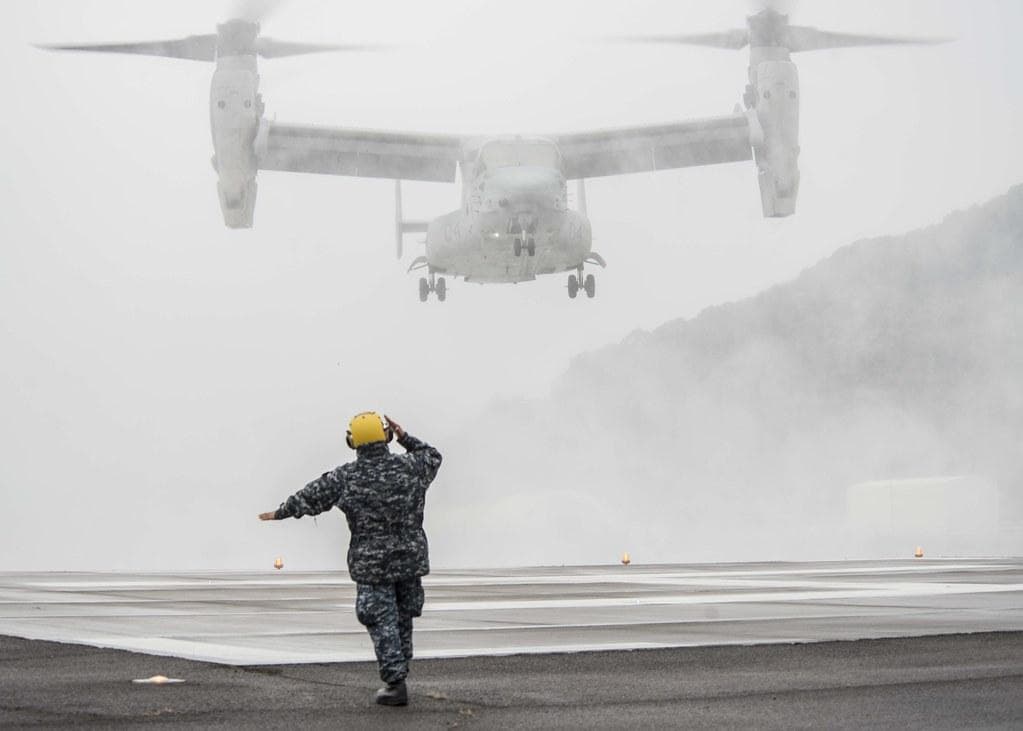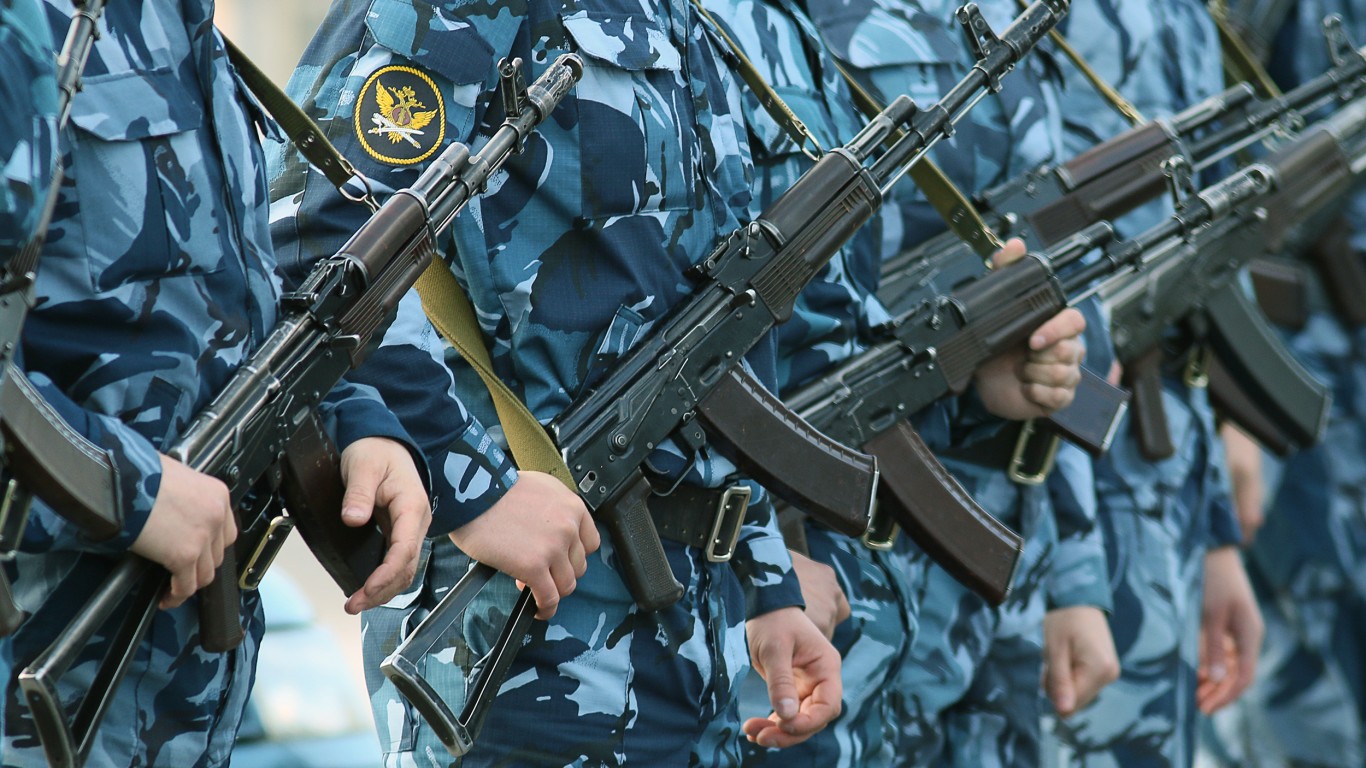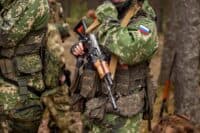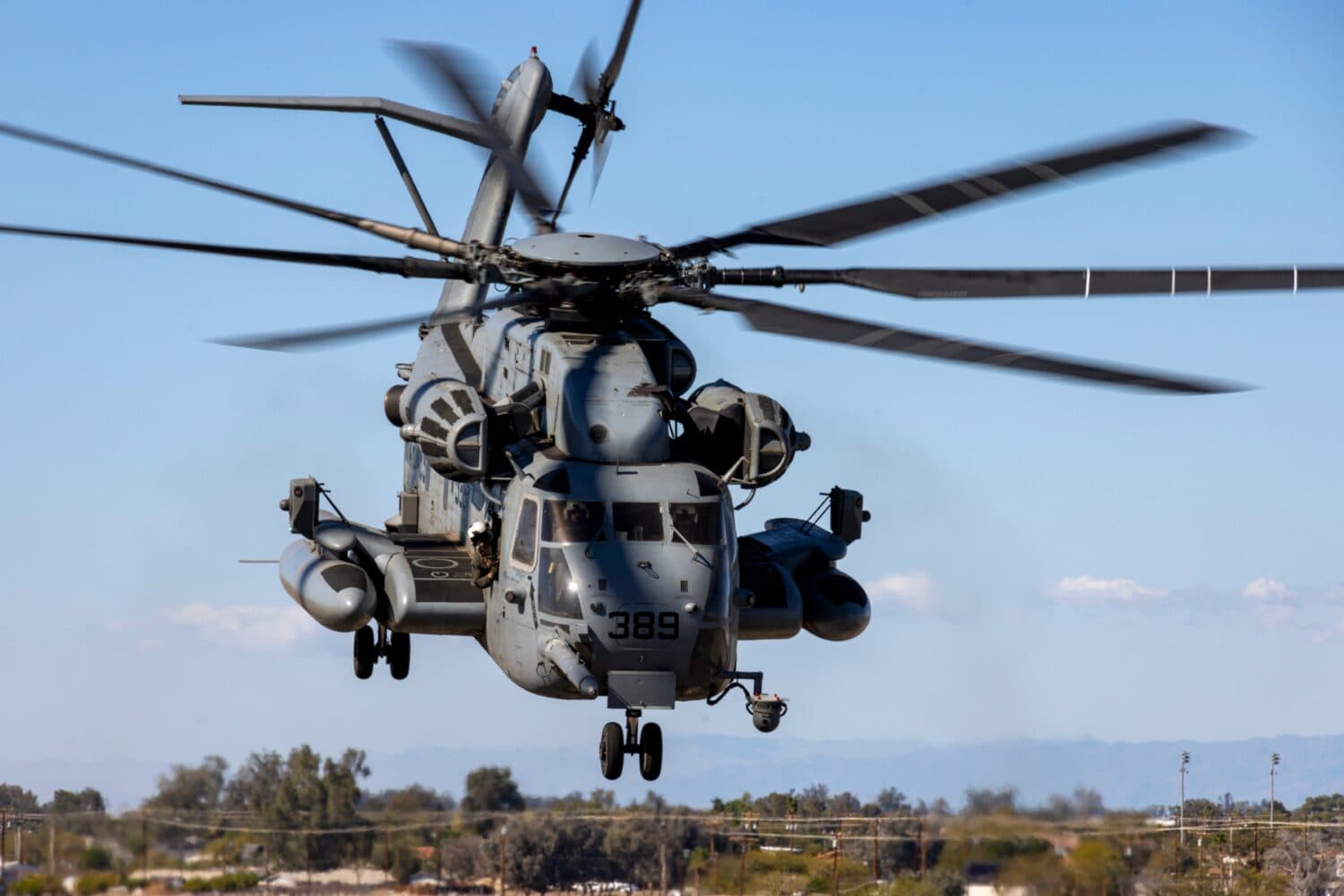
The United States Marine Corps is known as one of the fiercest fighting forces on Earth, and this is largely reflected in the firepower that its aircraft bring to the table. Today, we’re focusing on helicopters. The USMC has a handful of combat helicopters that are armed to the teeth with machine guns, rockets, and missiles. (This is what you’ll see inside a Marines Corps armory.)
While some of these helicopter’s function in more transport and logistical roles, they still come equipped with the necessary firepower should the need arise.
One of the mainstays of the Marine Corps is the AH-1Z Viper, a twin-engine attack helicopter that only entered service in 2010. These helicopters come with advanced targeting systems that play into the host of weapons they can equip. Its capabilities make it ideal for close air support and precision strikes. The Viper is essential for clearing paths for ground troops, disrupting enemy fortifications, and it can take out enemy armor if needed.
The AH-1Z’s original design is rooted in the iconic AH-1 Cobra, which is one of the first dedicated attack helicopters that rose to prominence during the Vietnam War. Notably, one of the biggest upgrades from its predecessors is its twin-engine design, powered by General Electric T700-GE-401C turboshaft engines, which allow the Viper to hit much higher speeds than most helicopters. With these, the Viper ranks as one of the fastest attack helicopters in the world, hitting speeds over 250 mph.
The Viper has been deployed in a few combat theaters, including Afghanistan and Iraq, where its speed and firepower have been instrumental in providing close air support to ground troops. These helicopters have also been incredibly useful in anti-armor strikes as well as reconnaissance missions. (This country has over 800 Apache attack helicopters.)
24/7 Wall St. is not looking at just the AH-1Z Viper but all of the U.S. Marine Corps’ combat helicopters. To identify the most heavily armed helicopters in the U.S. Marine Corps, 24/7 Wall St. reviewed the 2024 World Air Forces report from FlightGlobal, an aviation and aerospace industry publication. We ordered these helicopters by their armament, and excluded those without. We also included supplemental data on the type of helicopter, top speed and more. We excluded trainer aircraft.
Here is a look at the most heavily armed U.S. Marine Corps helicopters:
Why Are We Covering This?

Understanding the aircraft used by the U.S. Marine Corps provides insight into joint military capabilities and expeditionary defense strategies. Knowing what the Marine Corps has in its arsenal sheds light on its unique ability to project power quickly and operate in different environments. This also gives context to the tactical flexibility and logistical reach the Corps brings to its operations, from amphibious assaults to close air support. Lastly, the composition and technological sophistication of the Marine Corps’ aircraft fleet highlight its ability to maintain dominance and execute rapid response missions.
5. MV-22 Osprey
- Type: Tilt rotor VTOL aircraft
- Year introduced: 2007
- Active aircraft: 288
- Top speed: 316 mph
- Armament: 7.62mm machine guns, 12.7mm machine guns
Known for its unique ability to take off and land vertically like a helicopter and then adjust its rotors to operate like a turboprop plane, the MV-22 Osprey is one of the more unique aircraft in the U.S. Air Force. It is manufactured by Bell Boeing and plays key roles in U.S. special operations missions like infiltration, extraction, and resupply. The U.S. Navy uses this aircraft extensively for troop deployment and extraction, or even just for logistical purposes. The Osprey also can refuel mid-flight which significantly extends its range for longer missions.
Since its introduction, the MV-22 Osprey has seen action in major operations, including Iraq, Afghanistan, and humanitarian missions worldwide, typically filling a logistical role. In terms of its cargo, the Osprey is capable of carrying up to 24 combat-loaded Marines or 20,000 pounds of internal or external cargo.
4. CH-53K King Stallion

- Type: Heavy-lift transport helicopter
- Year introduced: 2018
- Active aircraft: 11
- Top speed: 196 mph
- Armament: 12.7mm heavy machine guns, 12.7mm GAU-21 miniguns
The CH-53K King Stallion is the newest heavy-lift helicopter to enter the U.S. Marine Corps’ arsenal. It is truly a game changer in military aviation. Built by Sikorsky, the King Stallion is capable of lifting over 36,000 pounds, which is roughly three times more than its predecessor, the CH-53E Super Stallion.
Also, the CH-53K has undergone serious upgrades further improving on the Super Stallion design from the 1980s. This newer variant incorporates fly-by-wire controls which allow for better precision in piloting as well as improved fuel efficiency and range. The King Stallion also features larger cargo space and upgraded avionics and sensors.
The King Stallion can hit a top speed of nearly 200 mph, and can be equipped with 12.7mm general purpose heavy machine guns and 12.7mm GAU-21 miniguns.
3. CH-53E Super Stallion

- Type: Super heavy-lift transport helicopter
- Year introduced: 1981
- Active aircraft: 135
- Top speed: 196 mph
- Armament: 12.7mm heavy machine guns, 12.7mm GAU-21 miniguns
The CH-53E Super Stallion has been the workhorse of the Marine Corps since the early 1980s. It’s designed to transport large payloads and can lift roughly 12,000 pounds externally. The CH-53K is the upgraded version of this helicopter that debuted nearly four decades later.
One of the Super Stallion’s key features is its aerial refueling capability, which allows it to extend its operational range for longer missions. This feature, along with its ability to operate from amphibious assault ships, gives the CH-53E the reach to perform missions at land and sea.
The Super Stallion has an impressive combat record as well, serving in operations like Desert Storm, Afghanistan and Iraq.
The CH-53E is powered by three General Electric T64-GE-416/416A turboshaft engines, each producing around 4,380 horsepower. These allow for the CH-53E to hit speeds of nearly 200 mph.
2. UH-1Y Venom

- Type: Medium-lift utility / transport helicopter
- Year introduced: 2009
- Active aircraft: 127
- Top speed: 190 mph
- Armament: 7.62mm machine guns, 12.7mm GAU-16/A gatling guns, hydra rocket pods
The UH-1Y Venom, affectionately known as the “Yankee”, is a key asset of the U.S. Marine Corps. Manufactured by Bell, the Venom is an upgraded version of the iconic UH-1 Huey that played an important role in the Vietnam War. The Venom can perform a wide range of missions, including troop transport, close air support, medical evacuation, and reconnaissance. It can carry a variety of weapons, including machine guns to rocket pods.
What sets the UH-1Y apart from its predecessor is its advanced avionics and sensor systems. Also its improved twin engine setup (General Electric T700) allows for much greater speeds.
1. AH-1Z Viper
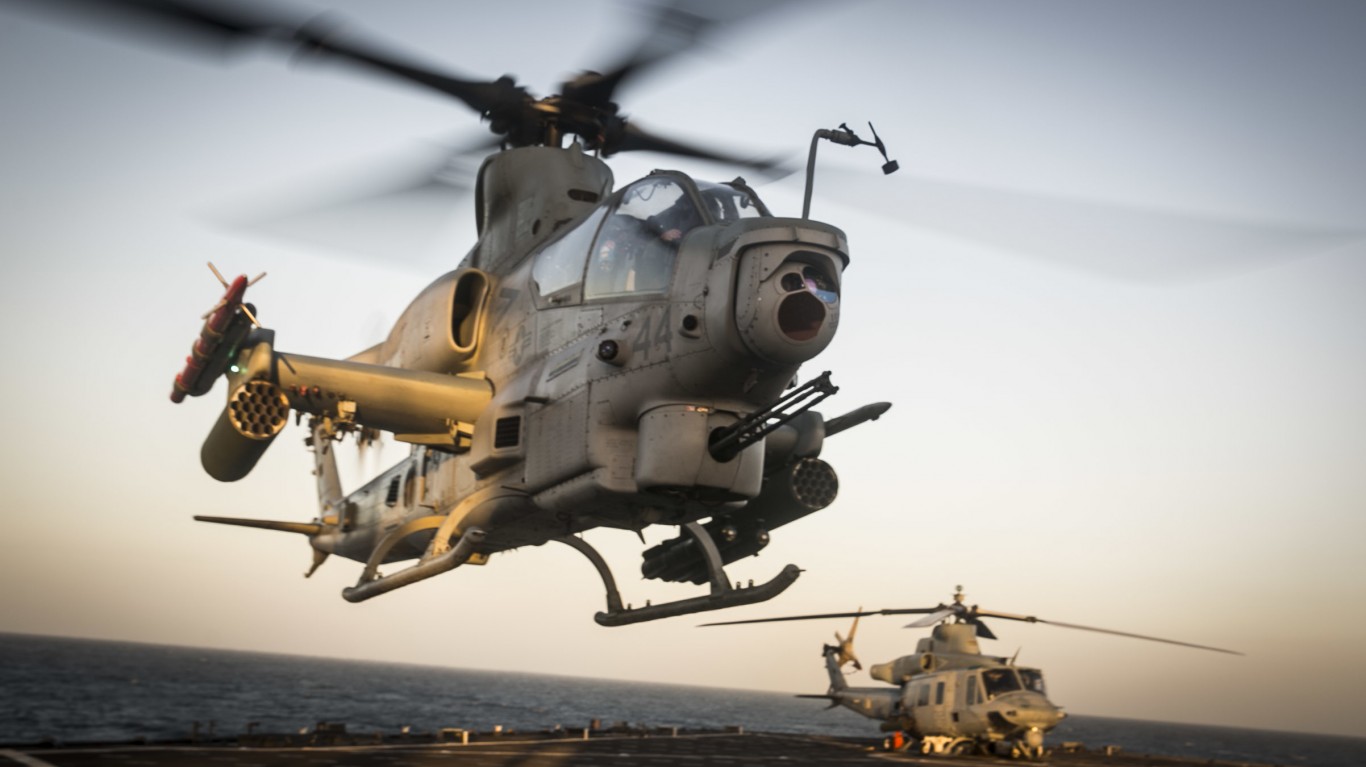
- Type: Twin-engine attack helicopter
- Year introduced: 2010
- Active aircraft: 176
- Top speed: 255 mph
- Armament: 20mm M196 cannon, Hellfire missiles, air-to-surface missiles, Sidewinder missiles, Hydra rocket pods
Known affectionately as “Zulu”, the AH-1Z Viper is a twin-engine attack helicopter and key asset of the U.S. Marine Corps. Developed by Bell, the Viper is the next evolution of the Cobra series, and these come with greatly improved agility and firepower.
The Viper is one of the most heavily armed aircraft at the disposal of the Marine Corps. These helicopters see a wide range of missions, including close air support, anti-armor strikes, and reconnaissance. As such, they are outfitted with Hellfire missiles, Sidewinder missiles, Hydra 70 rocket pods, and come standard with a nose-mounted 20mm cannon.
Powered by two General Electric T700-GE-401C turboshaft engines, the Viper can reach a top speed of 255 mph, making it one of the fastest and most maneuverable attack helicopters in service.
Get Ready To Retire (Sponsored)
Start by taking a quick retirement quiz from SmartAsset that will match you with up to 3 financial advisors that serve your area and beyond in 5 minutes, or less.
Each advisor has been vetted by SmartAsset and is held to a fiduciary standard to act in your best interests.
Here’s how it works:
1. Answer SmartAsset advisor match quiz
2. Review your pre-screened matches at your leisure. Check out the advisors’ profiles.
3. Speak with advisors at no cost to you. Have an introductory call on the phone or introduction in person and choose whom to work with in the future
Thank you for reading! Have some feedback for us?
Contact the 24/7 Wall St. editorial team.
